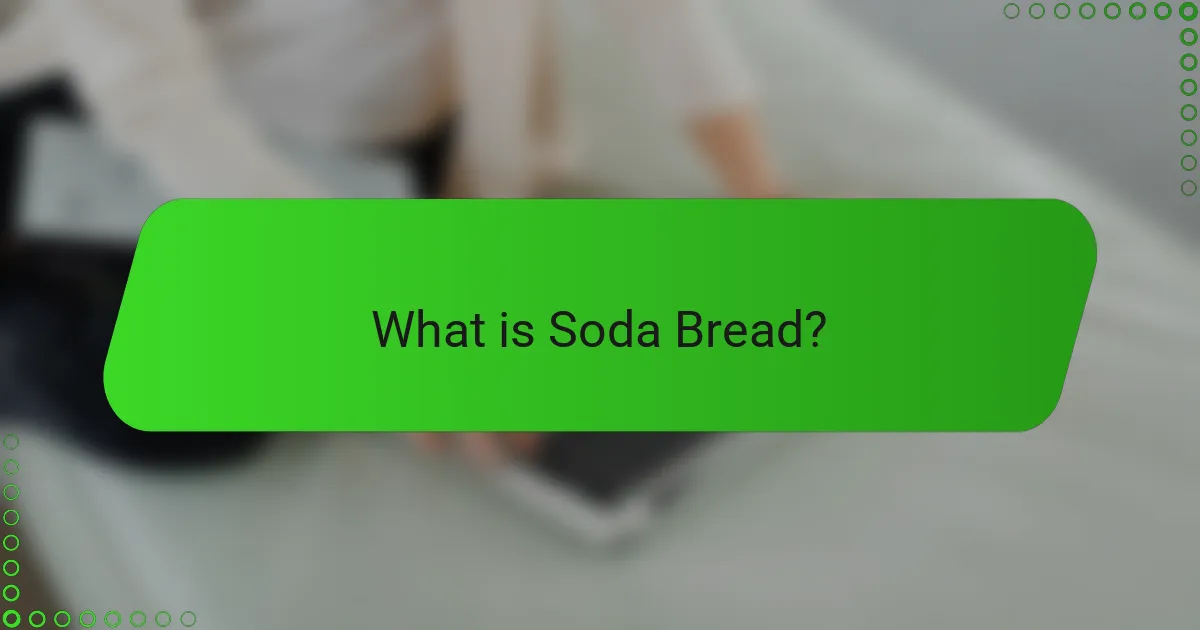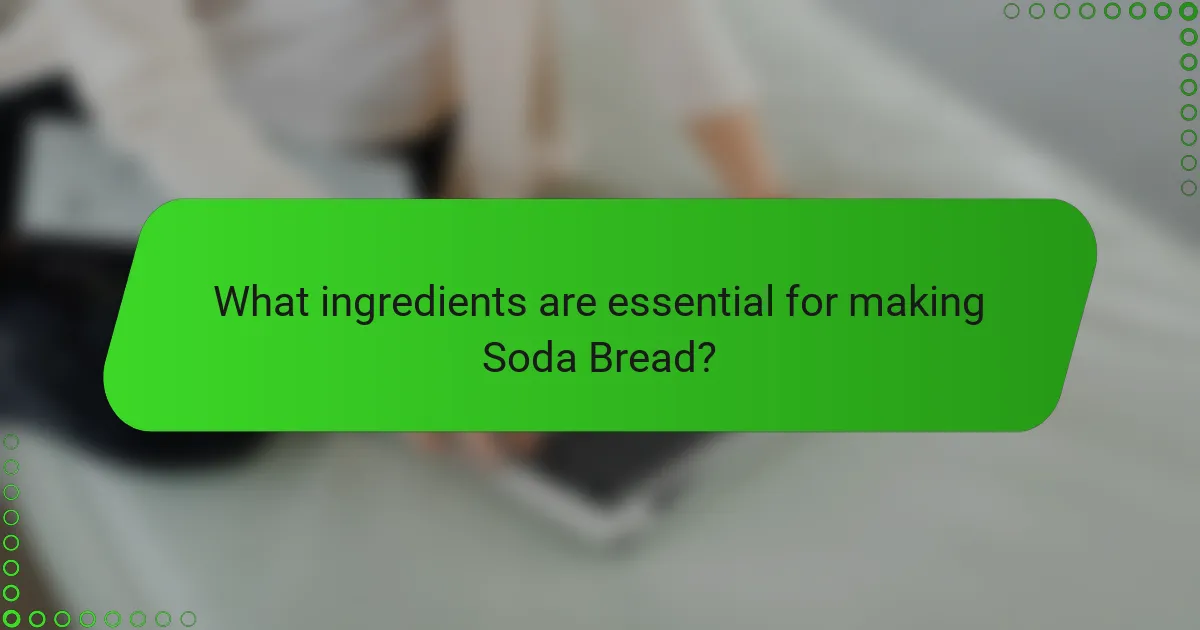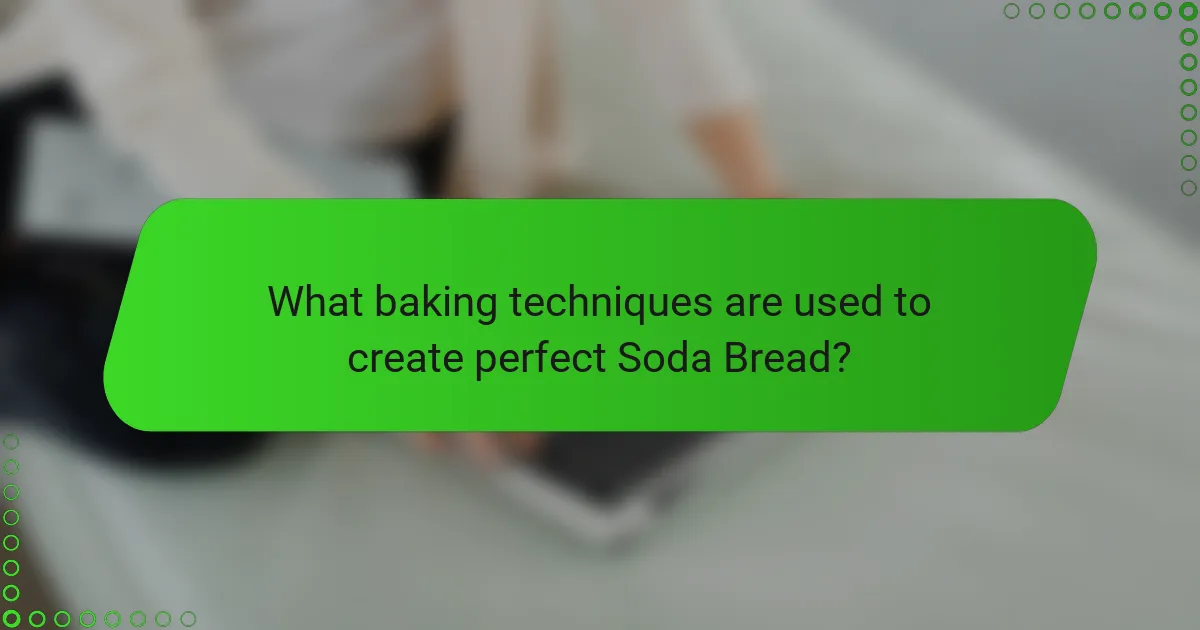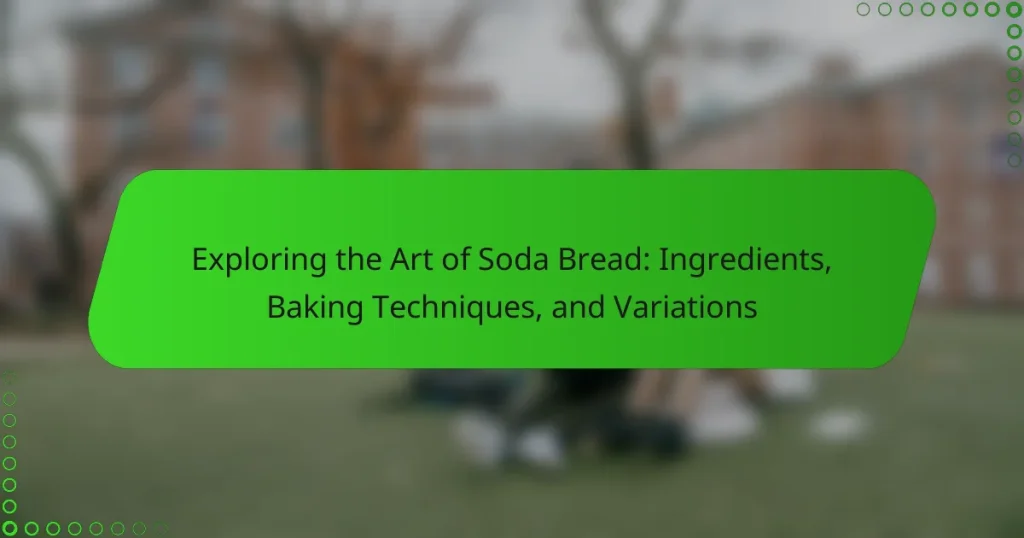Soda bread is a type of quick bread that uses baking soda as a leavening agent, distinguishing it from traditional yeast-based breads. The bread is made with simple ingredients: flour, baking soda, salt, and buttermilk, which interact to create carbon dioxide and a characteristic dense texture with a slightly tangy flavor. This article covers essential ingredients and baking techniques for making soda bread, including tips for achieving the right texture and variations such as brown soda bread, raisin soda bread, and gluten-free options. Each variation offers unique flavors and textures, showcasing the versatility of soda bread in households.

What is Soda Bread?
Soda bread is a type of quick bread that uses baking soda as a leavening agent. Unlike traditional breads that rely on yeast, soda bread rises due to the chemical reaction between baking soda and acidic ingredients, such as buttermilk. This process creates carbon dioxide bubbles that help the dough rise. Soda bread is typically made with simple ingredients, including flour, salt, baking soda, and buttermilk. It is known for its dense texture and slightly tangy flavor. Originating in Ireland, soda bread has become a staple in many households. The bread can be prepared in various forms, including round loaves or shaped into flatbreads.
How is Soda Bread different from other types of bread?
Soda bread differs from other types of bread primarily due to its leavening agent. It uses baking soda instead of yeast for rising. This results in a quicker preparation time compared to yeast breads. Soda bread typically has a denser texture. It also develops a unique flavor profile due to the reaction between baking soda and acidic ingredients like buttermilk. Unlike traditional breads, soda bread does not require proofing time. This makes it suitable for quick baking. The absence of yeast also means it has a shorter shelf life.
What are the key ingredients that define Soda Bread?
The key ingredients that define soda bread are flour, baking soda, salt, and buttermilk. Flour serves as the primary structure of the bread. Baking soda acts as the leavening agent, creating a light texture. Salt enhances the flavor of the bread. Buttermilk provides acidity, which reacts with baking soda to produce carbon dioxide. This reaction helps the bread rise during baking. Traditional Irish soda bread typically uses white flour, but whole wheat flour can also be included. These ingredients combine to create a quick bread that does not require yeast. The simplicity of these ingredients reflects soda bread’s historical roots in Ireland.
Why is baking soda used as a leavening agent?
Baking soda is used as a leavening agent because it produces carbon dioxide gas when it reacts with an acid. This gas creates bubbles in the dough, causing it to rise. Common acids that activate baking soda include vinegar, buttermilk, and yogurt. The release of carbon dioxide occurs immediately upon mixing, which is crucial for quick breads like soda bread. This reaction helps achieve a light and airy texture in the final product. The effectiveness of baking soda as a leavening agent is well-documented in baking science.
What are the historical origins of Soda Bread?
Soda bread originated in Ireland in the early 19th century. It emerged as a result of the introduction of bicarbonate of soda as a leavening agent. This method allowed for quicker bread-making compared to traditional yeast fermentation. The use of soda was particularly beneficial in regions with limited access to yeast. Soda bread quickly became a staple in Irish households. It was often made with wholemeal flour, which was more nutritious. The bread’s simple ingredients reflected the economic conditions of the time. Today, soda bread is associated with Irish culture and cuisine.
How did cultural influences shape the evolution of Soda Bread?
Cultural influences significantly shaped the evolution of soda bread. Originating in Ireland, soda bread reflects local agricultural practices and available ingredients. The use of baking soda emerged as a reaction to the scarcity of yeast. Irish traditions emphasized simplicity and resourcefulness in cooking. Immigrant communities adapted soda bread recipes to include regional flavors. Cultural exchanges introduced variations like the addition of fruits or spices. Historical events, such as the Great Famine, also impacted its ingredients and preparation methods. These factors collectively contributed to the diverse forms of soda bread seen today.
What role does Soda Bread play in traditional Irish cuisine?
Soda bread is a staple in traditional Irish cuisine. It serves as a daily bread, often accompanying meals. Soda bread is made using simple ingredients like flour, baking soda, salt, and buttermilk. This simplicity reflects the resourcefulness of Irish cooking. Historically, soda bread became popular in the 19th century due to the availability of baking soda. It is also a symbol of Irish heritage and culture. Many families have their own unique recipes passed down through generations. Soda bread is often enjoyed with butter, jam, or as part of a hearty Irish breakfast. Its versatility makes it a beloved food in Ireland.

What ingredients are essential for making Soda Bread?
Essential ingredients for making soda bread include flour, baking soda, salt, and buttermilk. All-purpose flour is commonly used for its structure. Baking soda acts as a leavening agent, helping the bread rise. Salt enhances flavor and balances the bread’s taste. Buttermilk provides acidity, which reacts with baking soda to create carbon dioxide. This reaction results in the bread’s characteristic texture. These ingredients are fundamental to traditional soda bread recipes.
What are the primary ingredients used in Soda Bread recipes?
The primary ingredients used in soda bread recipes are flour, baking soda, salt, and buttermilk. Flour serves as the main structure of the bread. Baking soda acts as the leavening agent, creating a rise. Salt enhances flavor and balances the taste. Buttermilk provides moisture and acidity, which reacts with baking soda. This combination results in a dense yet tender bread. Traditional recipes often use whole wheat flour, but all-purpose flour is also common.
How does the choice of flour affect the texture of Soda Bread?
The choice of flour significantly impacts the texture of soda bread. Different flours contain varying levels of protein and gluten. All-purpose flour creates a balanced texture, yielding a soft crumb. Whole wheat flour adds density and a nutty flavor, resulting in a coarser texture. Bread flour, with its higher protein content, produces a chewier and more elastic loaf. The moisture absorption of flour also affects the bread’s hydration level. Higher protein flours absorb more liquid, leading to a firmer texture. In contrast, lower protein flours create a lighter and more tender crumb. Ultimately, the flour type determines the overall mouthfeel and structural integrity of the soda bread.
What role do dairy products play in the recipe?
Dairy products in soda bread provide moisture and richness. They enhance the flavor and texture of the bread. Ingredients like buttermilk contribute acidity, which reacts with baking soda. This reaction helps the bread rise and develop a light crumb. Additionally, dairy adds nutritional value, including calcium and protein. The use of dairy can also influence the browning of the crust. Overall, dairy products are essential for achieving the desired taste and structure in soda bread.
Are there any alternative ingredients for dietary restrictions?
Yes, there are alternative ingredients for dietary restrictions in soda bread. Common substitutes include gluten-free flour for those with gluten intolerance. Almond milk or soy milk can replace dairy milk for lactose intolerance. Applesauce is a suitable alternative for eggs in vegan diets. Additionally, using maple syrup instead of sugar accommodates those avoiding refined sugars. These alternatives maintain the integrity of the recipe while catering to specific dietary needs.
How can gluten-free flour be used to make Soda Bread?
Gluten-free flour can be used to make soda bread by substituting it for traditional wheat flour. The key is to use a gluten-free flour blend that includes binding agents like xanthan gum. This helps mimic the structure provided by gluten in regular soda bread.
To prepare, mix the gluten-free flour with baking soda, salt, and any desired flavorings. Then, add buttermilk or a dairy-free alternative to create the dough. Knead the dough gently, as gluten-free flour requires less handling. Shape the dough into a round loaf and score the top to allow for even baking.
Bake the soda bread in a preheated oven at 425°F for about 30-40 minutes. The bread should have a golden crust and sound hollow when tapped on the bottom. This method results in a delicious gluten-free soda bread that maintains a similar texture and flavor to traditional versions.
What are substitutes for buttermilk in Soda Bread recipes?
Common substitutes for buttermilk in soda bread recipes include yogurt, milk with vinegar, and sour cream. Yogurt can be used in equal amounts as buttermilk. Milk mixed with vinegar or lemon juice creates a similar acidity; use one tablespoon of vinegar or lemon juice per cup of milk. Sour cream can also replace buttermilk in equal measurements. These substitutes maintain the desired texture and flavor in soda bread.

What baking techniques are used to create perfect Soda Bread?
To create perfect soda bread, specific baking techniques are essential. First, use the right flour, typically a combination of all-purpose and whole wheat. This blend provides the necessary structure and flavor. Second, incorporate baking soda as the leavening agent, which reacts with acidic ingredients like buttermilk. This reaction produces carbon dioxide, helping the bread rise.
Next, mix the ingredients gently to avoid overworking the dough. Overmixing can lead to a dense texture. Shape the dough into a round loaf and score the top with a knife. Scoring allows for expansion during baking. Bake the bread in a preheated oven at a high temperature, usually around 425°F (220°C), for about 30 minutes. The high heat creates a crusty exterior while keeping the inside soft.
Finally, check for doneness by tapping the bottom of the loaf; a hollow sound indicates it is fully baked. These techniques ensure a light, flavorful, and perfectly textured soda bread.
How do you properly mix and knead Soda Bread dough?
To properly mix and knead soda bread dough, start by combining the dry ingredients in a large bowl. This includes flour, baking soda, and salt. Mix them thoroughly using a whisk or fork to ensure even distribution. Next, create a well in the center of the dry ingredients. Pour in the buttermilk or milk gradually, mixing with one hand or a wooden spoon. Incorporate the flour from the sides of the bowl until a shaggy dough forms.
Once the dough has come together, transfer it to a lightly floured surface. Knead the dough gently for about 30 seconds. The goal is to bring the dough together without overworking it. Soda bread does not require extensive kneading like yeast bread. Shape the dough into a round loaf, ensuring it remains slightly rough on the surface. Finally, place the loaf on a baking sheet and score the top with a knife to allow for even baking.
What are the best practices for shaping Soda Bread?
The best practices for shaping soda bread include using a light touch and minimal handling of the dough. This preserves the air pockets that contribute to the bread’s texture. First, flour your work surface to prevent sticking. Next, gently turn the dough out onto the floured surface. Form the dough into a round or oval shape, ensuring not to over-knead. This helps maintain the bread’s tenderness.
Once shaped, place the dough on a baking sheet lined with parchment paper. Score the top with a deep cross to allow for even cooking and to create a traditional appearance. Finally, bake the bread in a preheated oven at 425°F (220°C) for about 30 minutes. This temperature promotes a good rise and crust formation.
How does the baking time and temperature influence the outcome?
Baking time and temperature significantly influence the outcome of soda bread. Higher temperatures create a crustier exterior while shorter baking times can lead to a doughy center. Conversely, lower temperatures allow for more even cooking but may result in a softer crust. The Maillard reaction, which browns the crust, occurs optimally at temperatures around 350°F to 450°F. Baking soda, the leavening agent, reacts with moisture and heat, producing carbon dioxide that helps the bread rise. If the bread is underbaked, it may collapse due to insufficient gas production. Overbaking can dry out the bread, affecting texture and flavor. Therefore, precise control of baking time and temperature is crucial for achieving the desired texture and taste in soda bread.
What are common mistakes to avoid when baking Soda Bread?
Common mistakes to avoid when baking soda bread include using old baking soda. Fresh baking soda is crucial for proper leavening. Another mistake is over-kneading the dough. This can result in a tough texture instead of a light and airy loaf. Failing to measure ingredients accurately is also a frequent error. Precision in measuring flour and liquid ensures the right dough consistency. Not allowing the dough to rest can hinder the development of flavor. Allowing it to rest for at least 15 minutes is beneficial. Additionally, using the wrong type of flour can affect the bread’s texture. All-purpose flour typically works best for soda bread. Lastly, neglecting to preheat the oven can lead to uneven baking. A properly preheated oven ensures the bread rises correctly.
How can over-kneading affect the final product?
Over-kneading affects the final product by creating a dense and tough texture in soda bread. This occurs because excessive kneading develops gluten too much. The gluten strands become overly elastic and rigid. As a result, the bread fails to rise properly during baking. The final loaf may have a chewy consistency rather than a light and airy one. In contrast, properly kneaded dough retains a softer texture. This is crucial for achieving the desired crumb structure in soda bread. Therefore, controlling kneading time is essential for optimal results.
What signs indicate that Soda Bread is overbaked?
Soda bread is overbaked when it has a dark, hard crust. The crust may appear burnt or excessively brown. The interior of the bread becomes dry and crumbly. Overbaked soda bread often has an unpleasant, bitter flavor. Additionally, it may produce a hollow sound when tapped on the bottom. These signs indicate that the bread has exceeded the optimal baking time. Proper baking should yield a golden-brown crust and moist interior.

What variations of Soda Bread can you try?
You can try several variations of soda bread. Traditional Irish soda bread is made with flour, baking soda, salt, and buttermilk. Brown soda bread includes whole wheat flour, adding a nutty flavor. Raisin soda bread incorporates dried fruit for sweetness. Herb and cheese soda bread features fresh herbs and cheese for a savory twist. Gluten-free soda bread uses gluten-free flour alternatives. Soda bread can also be made with different types of milk, like almond or oat milk, for dairy-free options. Each variation offers a unique taste and texture.
What are popular flavor additions to Soda Bread?
Popular flavor additions to soda bread include raisins, caraway seeds, and herbs. Raisins add sweetness and moisture to the bread. Caraway seeds provide a distinct, slightly nutty flavor. Fresh herbs like rosemary or thyme can enhance the aroma and taste. Other additions may include cheese for richness or nuts for texture. These ingredients are commonly used in various regional recipes. Each addition contributes to the unique character of the soda bread.
How can you incorporate fruits and nuts into your Soda Bread?
To incorporate fruits and nuts into your Soda Bread, mix them into the dry ingredients before adding any wet components. Dried fruits like raisins, cranberries, or apricots can enhance flavor and moisture. Chopped nuts such as walnuts or almonds add texture and nutrition. Use about one cup of mixed fruits and nuts for a standard recipe. Ensure the fruits are chopped to avoid clumping. Nuts should be toasted for added flavor. The combination of these ingredients creates a balanced taste profile. This method is commonly used in various Soda Bread recipes to achieve a delightful variation.
What are some regional variations of Soda Bread around the world?
Soda bread has several regional variations around the world. In Ireland, traditional soda bread is made with buttermilk and whole wheat flour. This version often includes baking soda as the leavening agent. In the United States, particularly in the Appalachian region, soda bread may incorporate cornmeal and is often sweetened with molasses. Scottish soda bread, known as “soda scones,” typically features a lighter, fluffier texture and may include currants or raisins. In Newfoundland, Canada, soda bread is often prepared with added ingredients like blueberries or baked as a loaf. Each variation reflects local ingredients and cultural preferences.
How can you customize Soda Bread for special occasions?
You can customize soda bread for special occasions by incorporating unique ingredients and flavors. Adding dried fruits like raisins or cranberries enhances sweetness. Incorporating nuts, such as walnuts or pecans, adds texture and flavor. Using herbs like rosemary or thyme can create a savory variation. For a festive touch, consider adding spices like cinnamon or nutmeg. You can also use different types of flour, such as whole wheat or oat flour, for a distinct taste. Shaping the bread into festive forms, like loaves or rolls, can elevate its presentation. Finally, glazing the bread with a mixture of egg wash or milk can give it a golden finish. These adjustments create a personalized soda bread suitable for celebrations.
What are some creative shapes and presentations for Soda Bread?
Soda bread can be creatively shaped and presented in various forms. Common shapes include traditional round loaves, which are often scored with a cross on top. Another option is to create soda bread rolls, which are smaller and easy to serve. A braided version can add visual appeal and elegance to the presentation.
For a rustic look, consider shaping the dough into a free-form loaf. This allows for unique textures and crust variations. Alternatively, soda bread can be made into flatbreads, which are great for dipping or serving with spreads.
Presentation can be enhanced by serving the bread on wooden boards or in woven baskets. Adding herbs or seeds on top before baking can also elevate the visual appeal. These creative shapes and presentations not only make soda bread more attractive but also enhance the overall dining experience.
How can you pair Soda Bread with different dishes or beverages?
Soda bread pairs well with a variety of dishes and beverages. It complements soups, especially hearty ones like Irish stew or vegetable soup. The bread’s texture enhances the meal while providing a satisfying contrast. Additionally, soda bread works well with cheeses, particularly sharp or creamy varieties. Cheese platters featuring cheddar or brie benefit from the bread’s mild flavor.
Soda bread also pairs nicely with smoked salmon or cured meats. The bread’s density balances the richness of these proteins. For beverages, soda bread is excellent with tea or coffee. The slight sweetness of the bread enhances the flavors of these drinks. It can also accompany Irish whiskey, creating a traditional pairing experience.
These pairings are rooted in Irish culinary traditions, where soda bread is a staple. The versatility of soda bread allows it to be enjoyed in various contexts, making it a popular choice for many meals and occasions.
What tips can help you master the art of Soda Bread baking?
To master the art of soda bread baking, focus on using fresh ingredients. Fresh baking soda is crucial for proper leavening. Ensure your flour is of good quality and not expired. Mix the dry ingredients thoroughly before adding wet components. This ensures even distribution of the baking soda. Use buttermilk for a tender crumb and distinct flavor. Avoid over-kneading the dough, as this can lead to a tough texture. Instead, mix until just combined. Shape the dough gently and create a cross on the top before baking. This helps the bread rise evenly. Bake at a high temperature, typically around 425°F (220°C), for a crispy crust.
Soda bread is a type of quick bread that uses baking soda as a leavening agent, resulting in a dense texture and slightly tangy flavor. This article explores the key ingredients, such as flour, baking soda, salt, and buttermilk, as well as the unique baking techniques that contribute to its preparation. It also delves into the historical origins of soda bread in Ireland, cultural influences, and various regional and flavor variations. Additionally, the article provides tips for mastering soda bread baking, including common mistakes to avoid and creative presentation ideas for special occasions.


